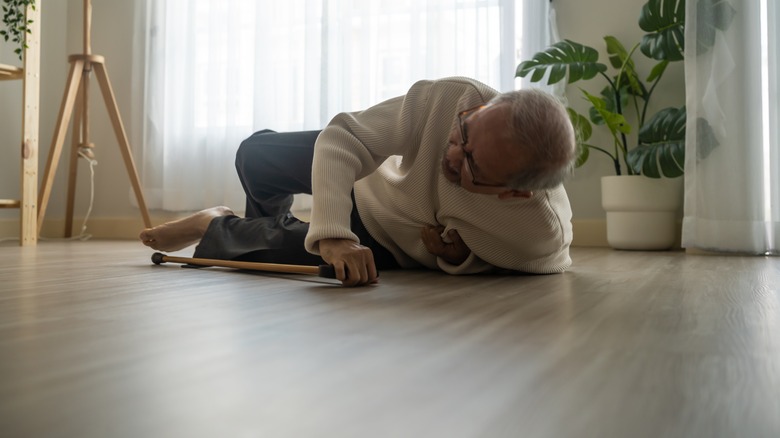When You Wear Glasses Every Day, This Is What Happens To Your Body
Whether you're wearing glasses to see up close or far away, to correct astigmatism, or help you read, you're in good company. According to the Vision Council, almost 64% of U.S. adults wear prescription eyeglasses. The four most common vision problems that can be corrected with glasses are myopia, hyperopia, astigmatism and presbyopia (via Cleveland Clinic). Myopia (nearsightedness) is when you can see up close, but far-away objects appear blurry. Hyperopia (farsightedness) is when you can see far away, but up-close objects appear blurry. Astigmatism is a change in the shape of the cornea causing blurry or distorted vision. Presbyopia is an age-related condition when your eyes lose their ability to focus on nearby objects.
Wearing eyeglasses can improve your quality of life. A study published in the American Journal of Ophthalmology showed that people with under-corrected vision problems who were given new glasses were able to see and think more clearly. They were able to accomplish everyday tasks more easily, experienced less eye pain, and felt more independent and less isolated.
With the wide variety of styles and colors available, eyeglasses can also be a fun and trendy fashion statement. In addition to glass, lenses are also available in plastic, making them lightweight and shatter-resistant (per Cleveland Clinic). Wearing glasses can also have unexpected positive and negative effects on the rest of your body. Let's learn how.
You may experience fewer eye infections than you do with contacts
Glasses can be uncomfortable and inconvenient, but wearing contact lenses is not without its problems. For one thing, contact lens wearers experience more eye infections than eyeglass wearers (via WebMD). Why? Eyeglass wearers tend to touch their eyes less often, reducing the chance of transferring viruses, bacteria, fungi, or parasites to the eyes.
According to the American Academy of Ophthalmology (AAO), the most common cause of eye infections for contact lens wearers is keratitis, a bacteria that comes in contact with the lens and is transferred to the eye. Bacteria can be transferred to your eyes a number of ways. The Cleveland Clinic states that bacteria can build up on contact lenses that aren't properly cleaned or replaced on the recommended schedule. Topping off instead of replacing contact lens solution or not replacing the lens case regularly can also increase your risk of infection. Improper hygiene, such as not washing your hands with soap and water before inserting or removing your lenses, is a surefire way to transfer bacteria to your eyes. Water can carry pathogens, so don't swim while wearing contacts, or expose your lenses to water. And sleeping in your contact lenses is a definite no-no. Wearing contact lenses for too long reduces the amount of oxygen to your eyes and can lead to an eye infection.
Symptoms of an eye infection include irritation and redness, pain or feeling like you have sand or something in your eye, blurry vision, watering or discharge, and sensitivity to light (via AAO). Eye infections are not only uncomfortable, but they can also cause permanent eye damage. If you have any of these symptoms, see your eye doctor immediately.
You might experience less dizziness
Experiencing dizziness — feeling lightheaded, faint, or unsteady on your feet (via Mayo Clinic) — is frightening and can also be dangerous. Dizziness increases your risk of falls and accidents. Dizziness can be caused by things such as vision problems, mental health issues such as anxiety and stress, using certain medications, low blood sugar, migraine headaches, motion sickness, and neurological conditions. Ear infections or problems with the inner ear can affect balance and cause dizziness. It's important not to ignore episodes of dizziness, as they could be a symptom of something more serious.
Vision-related dizziness can be a symptom of binocular vision dysfunction (BVD). According to the Vestibular Disorder Association, binocular vision is how your eyes are aligned and work together to create a single visual image. BVD is a condition where the eyes are misaligned, making it difficult for them to send one clear picture to the brain. In addition to dizziness, BVD can cause blurred or double vision and make it difficult to read and drive. If you are diagnosed with BVD, your eye doctor can prescribe eyeglasses with built-in prisms. The prisms bend the image that your eyes see and bring your eyes back into alignment.
You can lower your risk of UV damage to your eyes
Most people know that staying out in the sun for too long without sun protection can cause sunburn. But did you know that you can also get sunburned eyes? Protecting your eyes from damaging UV rays is vital for eye health (via AAO). UV rays can damage all parts of the eye, including the eyelids. Overexposure to sunlight can lead to photokeratitis, or snow blindness, a painful condition where eyes are red, irritated, and extremely sensitive to light. Over time, overexposure to UV rays can lead to more serious diseases like eye cancers, macular degeneration, cataracts, and vision loss.
Prescription sunglasses with UV-A and UV-B protection are an option to help you protect your eyes from sun damage (per American Optometric Association). Regular prescription lenses made from plastic offer some built-in UV protection (via AAO). If you don't want to carry around two pairs of glasses, prescription glasses with an added protective UV coating or photochromatic lenses (also known as transition lenses) are convenient options. Transition lenses darken when exposed to sunlight and, unlike sunglasses, can be worn both indoors and outdoors.
You might experience less fatigue
If you find yourself constantly squinting to read a book or see what's up ahead, you know how tired eye strain can make you feel. In addition to fatigue, eye strain can cause eye pain, blurred vision, headaches, and lack of concentration, says EyeHealth Web. Spending too much time in front of the computer or reading in low lighting can strain the eyes. This type of eye strain from overuse is usually temporary and can be corrected by resting your eyes.
Eye strain and the resulting fatigue can also be caused by an underlying vision problem. Conditions like nearsightedness can be easily corrected by wearing glasses. In a study of nearsighted adolescents and adults, those who were given glasses to correct their vision experienced less eye strain and fatigue than those who did not wear glasses.
If you're experiencing frequent eye strain and fatigue, a comprehensive eye exam can help determine if you need glasses (per EyeHealth Web). In the meantime, you can reduce eye strain and fatigue by taking frequent breaks from your computer and cell phone screens and while reading, driving, or doing detailed, close-up work.
You may lower your risk of contracting COVID-19
Your eyeglasses may help protect you from getting COVID-19. According to the Centers for Disease Control and Prevention (CDC), COVID-19 is an upper respiratory tract infection caused by the coronavirus SARS-CoV-2. The infection can be contracted via your eyes, nose, or mouth from the droplets of an infected person's sneeze or cough. It can also be transmitted by touching an infected surface and then touching your mouth, nose, and eyes.
Two separate studies showed that people who wore glasses for eight or more hours a day were less susceptible to contracting COVID-19 as compared to the rest of the population. In a study of patients admitted into the hospital in the Hubei Province of China, the proportion of patients who wore glasses was lower than that of those who did not (via JAMA Ophthalmology). Another study of data on almost 13,000 subjects showed the associated risk of infection was 5.25% among eyeglass wearers and 10.2% for those who didn't wear glasses (per In Vivo).
This may be because wearing glasses provides a barrier between your eyes and people sneezing and coughing. Eyeglass wearers also tend to touch their eyes less often, and the glasses may remind you not to touch them. While the studies aren't conclusive, it's good to know that glasses may offer protection and reduce your risk of getting COVID-19. Strike another win for Team Glasses!
Your mental health may improve
Stress is a normal part of life, but vision problems can increase your level of stress and chances of developing anxiety and depression. The CDC reports that one in four adults suffers from anxiety or depression due to vision loss. Visually impaired children and young adults suffer from more anxiety and depression than the rest of their peers, according to a review in the Journal of Visual Impairment & Blindness. Girls, in particular, experience more severe episodes of anxiety and depression.
In addition to anxiety and depression, vision problems and vision loss can have severe effects on your everyday life. According to a report by the National Academies of Sciences, Engineering, and Medicine, vision loss can reduce your ability to read and learn, and make activities like driving or walking more difficult. Visual impairments can increase your feelings of social isolation and reduce your ability to be independent.
Taking care of your eye health is not only important for your vision, but also your mental health. According to the American Academy of Ophthalmology, addressing vision problems early on by getting regular eye exams and wearing the right glasses can help reduce or slow down the progression of vision loss.
You might perform better at school
Wearing glasses may improve academic performance. In two large-scale studies, poor vision was shown to have serious affects on a child's ability to learn and economic future. As part of one of the most extensive clinical studies of its kind, the Vision for Baltimore program provided 64,000 of the city's pre-K through eighth-grade students with eye exams and distributed over 8,000 pairs of glasses (via JAMA Ophthalmology). Researchers at Johns Hopkins University found that students improved their reading and math scores after receiving glasses. The improvement was particularly impressive among girls and the lowest performing students. In another study conducted by Stanford University's Rural Education Action Program, students in rural China who were given eyeglasses nearly doubled their academic achievement. Over nine months, students who wore glasses learned nearly twice as much, and their test scores increased by 14 points compared to those who didn't.
In order to help prevent or get an early diagnosis and treatment for vision problems or eye disease, the American Optometric Association (AOA) released their Comprehensive Pediatric Eye and Vision Examination Resource for Pediatricians. These guidelines recommend the following: Infants should have their first comprehensive eye exam and vision assessment between the ages of six and 12 months old. Pre-school children (three to five years old) should get at least one comprehensive eye exam, and school-aged children (six to 18 years old) should get a comprehensive eye exam annually.
You may increase your risk of falling
Vision problems can increase your chances of falling, but so can wearing new glasses. Getting new glasses can be fun, but it can also take time to get used to them. If you have ever switched from single to bifocal or transition lenses, you know how challenging it can be when you first start wearing them (via Science Direct). Things can seem closer or farther away than they are, and this can affect your balance.
Older adults who get new prescriptions with a significant increase in magnification experience an increased risk of falling while they become accustomed to the new glasses, according to a review in Optometry and Vision Science. To reduce the risk of falling, particularly in high-risk groups like the elderly, the review's author, Dr. David B. Elliott, recommends a conservative approach to prescriptive eyewear (via Science Direct). He recommends that eye doctors prescribe the minimum magnification possible to correct the visual impairment. Dr. Elliot does not recommend bifocal or transition lenses for at-risk patients who are used to single vision lenses unless it's absolutely necessary.
If you get new bifocal or transition lenses, wear them as much as possible to get used to them (via Healthgrades). Look through the bottom of the glasses to read or do up-close work. Look through the top of the glasses to see farther away or when walking. When taking the stairs, look through the top part of the glasses and use handrails.
You can experience tunnel vision
Tunnel vision is the reduction or loss of peripheral vision, which is the ability to see from the corner of your eyes, according to Psychology Today. There are many causes of tunnel vision, including glaucoma, eye injury, nerve and brain damage, or concussion. It turns out that wearing glasses may also reduce your peripheral vision by reducing your horizontal view and distorting the view through the lens area closest to the frame of the glasses.
Your visual field is comprised of central vision for looking straight ahead and peripheral vision, which lies outside the central view (via EyeHealth Web). Peripheral vision is the largest visual field, but eyeglasses are typically made to improve central vision (via Psychology Today). A typical person's horizontal visual field is 135 degrees. This horizontal field can be reduced to 90 or 115 degrees, depending on the width of the glasses and how close they are to the eyes. Additionally, the view from the lens area closest to the rim of the glasses can be blurry or distorted, making the horizontal visual field even smaller. Why should you care about this? Decreased peripheral vision can affect driving and walking, and increases your chances of falling (per Ophthalmology).
You may experience more neck, shoulder, and back pain
According to doctor of physical therapy Justine Cosman of Whole Body Health Physical Therapy, if you're experiencing neck, shoulder, or back pain, it may be because you're wearing the wrong prescription or bifocal lenses. If you constantly find yourself extending your arm out to read a menu or cellphone or tilting your head to get a clearer view, your prescription may be to blame. Poor posture from tilting your head forward to read fine print can cause neck, back, and shoulder pain.
Wearing bifocal lenses poses its own set of challenges. A study showed that bifocal wearers tilt their heads down to look through the bottom portion of the glasses to see up close. This repeated use of the deep cervical flexor muscles in the neck can lead to neck pain. According to Joseph Kleinkort, an American Physical Therapy Association spokesperson and ergonomic consultant, changing to trifocal lenses that correct near, distance, and intermediate vision or progressive lenses, similar to bifocals but without the division line, may help (via U.S. News & World Report).
You may reduce your risk of cognitive decline
Recent studies suggests that a regular eye exam may help your doctor identify your risk of developing dementia. Dementia is an umbrella term used to describe diseases caused by abnormal changes in the brain (via National Institute on Aging). These changes result in loss of memory as well as a diminished ability to think clearly, make decisions, and perform daily activities of living. In a study of 2,520 adults between the ages of 65 and 85, there was a strong association between declining vision and cognitive decline. Some key takeaways from the study indicated that people with the worst vision, depth perception, and contrast perception had a higher risk of memory decline.
Scientists are still trying to determine if vision impairments cause dementia, dementia causes visual impairments or both (via Ophthalmology). Either way, protecting your vision may also protect your cognitive health. Even if you haven't experienced any vision changes or issues, having a regular eye exam is essential for overall health, particularly for older adults.
You might increase your risk of eye injuries
While eyeglasses can improve your vision, they can also increase your risk of head, face, and eye injuries. A study by Ohio State University estimated that 27,000 eyeglass-related injuries send people to the emergency room annually (via Science Daily). The most common injuries include cuts to the face, head, and eyeball. The most common reason for the injuries include falls, sports, and recreational activities.
The good news is that 90% of these injuries are preventable. Wear safety goggles over your glasses when participating in activities at home or at work that expose your eyes to airborne particles, dust, splashes, or fumes. If you wear glasses and participate in sports, the American Academy of Ophthalmology recommends eyewear with impact-resistant and flexible frames with shatter-proof polycarbonate lenses. If you're a spectator at a sports event, be sure to pay attention at all times to avoid being hit by a ball, bat, or player running or falling into the stands.













